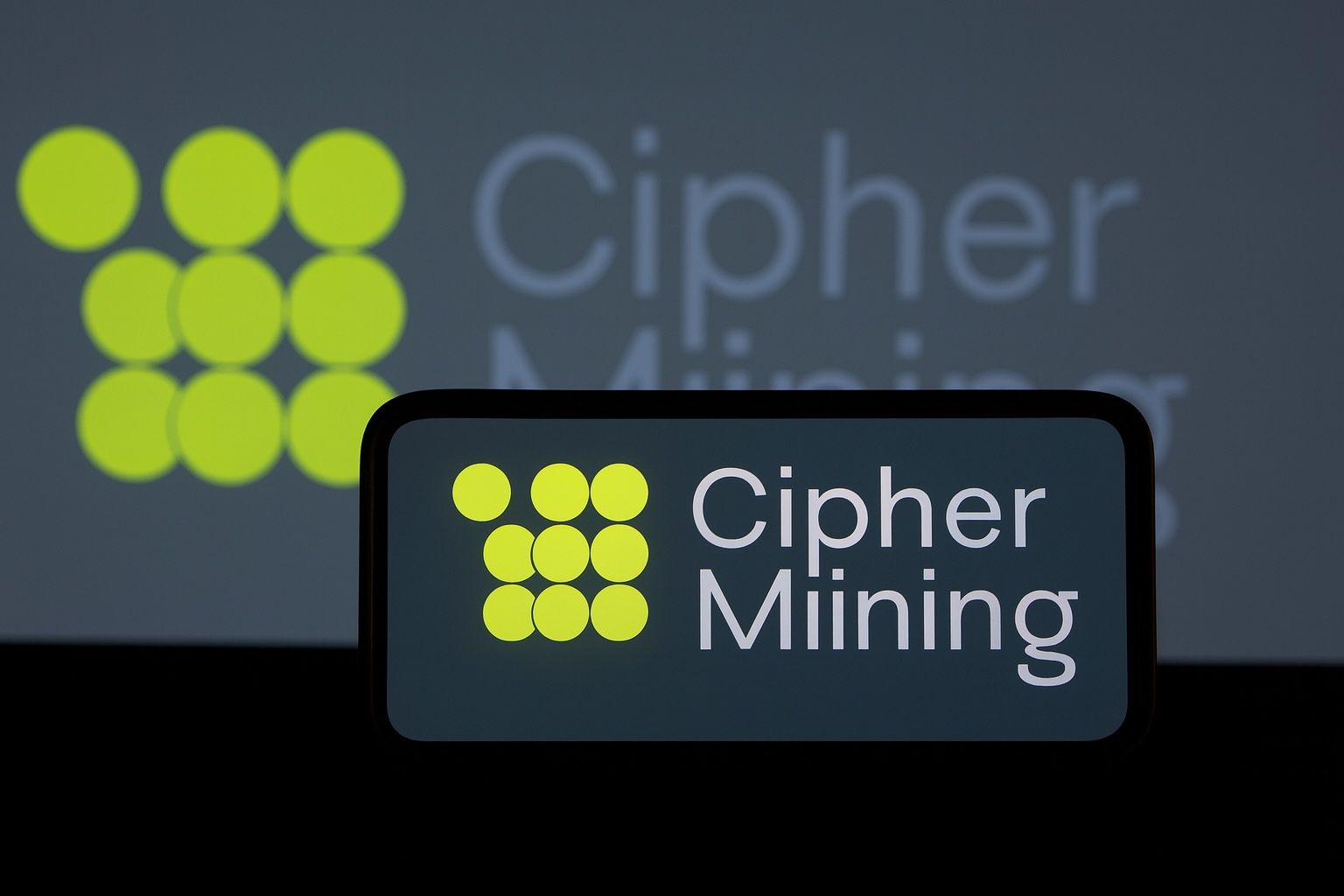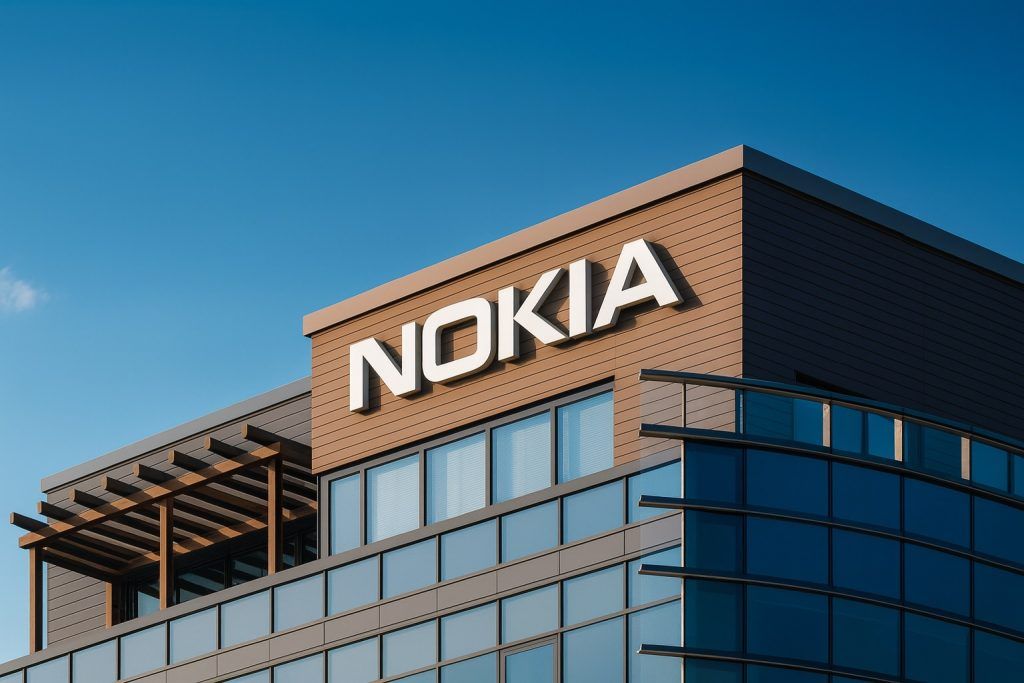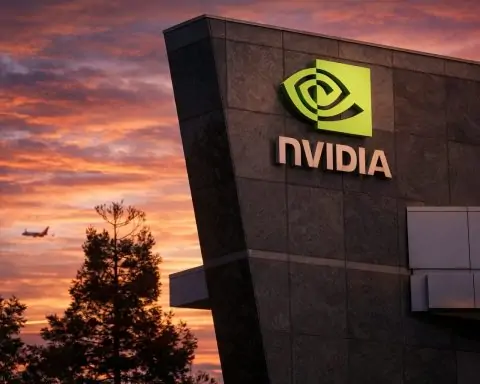- Wild 2025 Rally: Cipher Mining Inc. (NASDAQ: CIFR) surged over 300% year-to-date, hitting all-time highs around $20 per share in mid-October amid a Bitcoin price boom and a major AI hosting deal.
- October Pullback: The stock slid sharply this week, dropping ~12% on October 22 alone and roughly 24% over five sessions, as Bitcoin retreated from recent highs and crypto markets turned risk-off.
- Crypto Market Volatility:Bitcoin is hovering near $108K (down from ~$114K a day prior) [1] [2], and the total crypto market cap fell ~16% from its peak, pressuring miner stocks across the board.
- AI Pivot Powers Growth: Cipher’s transformative 10-year, $3B AI cloud hosting deal (backed by Google) bolstered its valuation. The company is diversifying beyond Bitcoin mining into high-margin AI data centers – a strategy peers are now emulating.
- Outlook Mixed:Analysts remain mostly bullish (12 “Buy” ratings, targets up to $25) but warn of volatility. Expert views diverge – some see further downside risk toward ~$6 if trends worsen, while others note institutional buyers are still accumulating shares.
CIFR’s Roller-Coaster Rally and Recent Plunge
Cipher Mining’s stock has been on a wild ride in 2025. Starting the year under $2, CIFR rocketed into the high teens and low $20s by mid-October. It closed October 13 at $20.34 (a record high, +19.9% that day) and even traded above $21 in after-hours. This meteoric rise – roughly +320% year-to-date – reflected a confluence of company-specific news and a surging crypto market. However, the momentum has since reversed. After peaking, CIFR pulled back sharply: it dipped to the mid-$17s on Oct. 21 and then slid further to the mid-$15 range on Oct. 22 as sellers hit the broader crypto sector [3]. By Wednesday afternoon (Oct. 22), the stock was down about 10–15% for the day [4] – part of a broader slump in Bitcoin-exposed equities.
Market watchers attribute Cipher’s sudden stumble largely to crypto market volatility. Bitcoin, which had just reached an all-time high around $125–126K in early October, fell back to ~$108K this week [5] [6]. “Crypto-related stocks, particularly bitcoin miners turned AI infrastructure plays, were suffering heavy losses on Wednesday,” CoinDesk reported, noting CIFR and peers tumbled 10–15% early in the session [7]. In just the past five trading days, Cipher’s stock shed roughly one-quarter of its value. This whiplash – from euphoria to pullback – has raised questions about how much of the rally was overextended. Still, even after the dip, CIFR remains massively up in 2025, far outperforming the S&P 500 and even Bitcoin itself over the year.
Major Drivers: Bitcoin Boom and an AI Cloud Pivot
Bitcoin’s 2025 bull run set the stage for Cipher’s ascent. Through mid-October, Bitcoin hovered around $115K to $120K [8], roughly 3× higher than a year ago, approaching record territory. This rally – fueled by record ETF inflows (over $6 billion in one week) and rising institutional adoption – sent mining stocks soaring across the board. High bitcoin prices directly boost miners’ revenue, and investors piled into names like Cipher to ride the wave. Notably, on October 13 when Bitcoin rebounded from a brief dip, Cipher spiked ~20% intraday amid a broader crypto-mining stock rally. Peers Bitfarms and Bitdeer surged ~26% and ~10% respectively that day, showing how tightly miner equities trade with crypto sentiment.
However, Cipher’s story isn’t just about Bitcoin. The company has aggressively pursued an “AI pivot” that sets it apart from a typical miner. In late September, Cipher announced a landmark 10-year hosting contract with Fluidstack (a cloud AI computing provider) that is backed by Google. Under the deal, Cipher will dedicate 168 MW of its new Texas data center to host AI workloads, with Google reportedly financing ~$1.4 billion of the contract and even taking a ~5% equity stake in Cipher. The contract is valued at roughly $3 billion in guaranteed revenue (expandable to $7B) over the decade – a massive sum for a company that had only ~$44M in quarterly revenue as of Q2 2025. Importantly, the AI hosting business is expected to generate 80–85% gross margins, far higher and more stable than the notoriously volatile margins in Bitcoin mining.
This transformative deal essentially pre-fills Cipher’s new 150 MW “Black Pearl” data center in Odessa, TX with a long-term, blue-chip tenant. It instantly legitimized Cipher as a hybrid Bitcoin miner + AI cloud play, a narrative that electrified investors. “Cipher’s stock has surged thanks to a transformational high-density data center deal – essentially an AI cloud pivot,” noted one analysis. The market reacted accordingly: CIFR stock jumped 9.6% on Oct. 2 when the news broke, then kept climbing on heavy volume for days. By Oct. 8, shares hit ~$18 (a ~7× gain since spring) amid frenzied buying and bullish commentary from analysts. In short, the combination of Bitcoin’s rally and Cipher’s AI/cloud pivot created a perfect storm for the stock’s explosive rise.
Broader Crypto Trends Squeeze and Support Miners
This week’s pullback in Cipher and its peers underscores the ongoing volatility in the crypto market. Bitcoin’s quick drop from ~$114K to ~$108K between Oct. 21 and 22 [9] [10] helped trigger a wave of profit-taking. The total crypto market cap slid to about $3.64 trillion (down over 16% from its ~$4.32T peak). As a result, crypto-exposed stocks – from miners like Cipher and Marathon to exchanges like Coinbase – have all felt the pain. “Momentum names are taking a beating… AI-related stocks leading that list,” CoinDesk observed in its market wrap [11] [12]. The popular CoinShares Bitcoin Mining Index ETF (ticker: WGMI), a sector proxy, was down ~7% on Oct. 22 [13], reflecting a broad pullback in mining equities.
Despite the near-term jitters, industry fundamentals remain robust. Bitcoin’s network hash rate recently hit all-time highs above 1 zettahash (1,000 EH/s) in late September [14], as miners deployed more machines to capitalize on the high prices. (By mid-October the hash rate eased slightly to ~1,030 EH/s [15], still about 38% of that powered by publicly-listed U.S. miners [16] [17].) Mining difficulty accordingly surged, which pressures profit margins per BTC mined – in fact, one JPMorgan analysis noted that “hashprice” (mining revenue per TH) fell ~7% in early October even as BTC rose [18] [19]. Nonetheless, at current Bitcoin levels around $100K+, mining remains highly profitable for efficient operators. Cipher, for instance, boasts some of the industry’s lowest power costs by building facilities next to wind and solar farms in West Texas [20]. That gives it a buffer as energy and difficulty costs climb.
Meanwhile, a broader trend of convergence between crypto mining and AI computing is underway. The surge in AI demand has led to data center capacity shortages – Microsoft warned that U.S. cloud data centers are at capacity until 2026 [21] – and this has actually benefited Bitcoin miners. Many miners have secured large power contracts and built out high-density cooling infrastructure, which can be repurposed for AI far faster than building new server farms from scratch [22] [23]. Wall Street firm Bernstein recently highlighted this dynamic, calling Bitcoin miners “strategic enablers” of the AI buildout since they control over 14 GW of power capacity ready to deploy [24] [25]. This context explains why companies like Cipher are landing AI hosting deals – and why investors have flocked to the “AI pivot” narrative across the crypto mining sector.
Peer Comparison: Cipher vs. Other Bitcoin Miners
Cipher’s rise and recent retrenchment closely mirror moves in other crypto mining stocks, though its AI deal has set it apart. Like CIFR, shares of Marathon Digital (MARA) and Riot Platforms (RIOT) – two of the largest U.S. Bitcoin miners – have soared in 2025. Marathon’s stock recently traded around $20 (near its 52-week high) [26], and Riot likewise hovered near $20–21 per share [27], each up several hundred percent from January levels. All three sported market capitalizations in the ballpark of $7–8 billion by mid-October [28]. These miners benefited from the same Bitcoin rally and renewed investor appetite. However, Cipher distinguished itself by securing a huge AI hosting contract, whereas Riot and Marathon remain primarily focused on expanding Bitcoin hash rate. This dual strategy gave Cipher an extra aura of growth, helping its stock outrun some peers until the recent pullback.
Other rivals also rode the wave. Iris Energy (IREN), an Australia-based miner with U.S. listings, surged over 500% year-to-date by early October [29], becoming another market darling due to its heavy emphasis on data center opportunities. Bitfarms (BITF), a Canadian miner, jumped from about $1 in January to the $4–5 range – a 400% leap – before cooling off [30]. On Oct. 22, CoinDesk noted Bitfarms had fallen ~40% from its peak, trading just above $4 [31]. Even industry veterans Hut 8 (HUT) and Hive Digital (HIVE) joined the fray: Hut 8’s stock ran up on Bitcoin’s strength (the company is in the process of merging with US Bitcoin Corp), and Hive announced bold plans to reach 35 EH/s of BTC capacity by 2026 while growing its HPC/AI operations 5× via new partnerships [32] [33]. Notably, CleanSpark (CLSK) – another U.S. miner – just announced an evolution from pure Bitcoin mining to include AI compute services [34], even hiring a Senior VP of AI data centers. This shows how Cipher’s peers are now pivoting to chase the same high-margin AI hosting opportunities that Cipher seized first.
In terms of operational scale, Cipher is in the top tier of miners. It had about 16.8 exahashes/second (EH/s) of Bitcoin mining capacity online by mid-2025, with a roadmap to reach ~23.5 EH/s by the end of 2025. That’s comparable to Marathon and Riot, which each hover in the 20–25 EH range. All are racing to install the latest-generation ASIC rigs to grab Bitcoin market share before the next halving in 2028. Cipher’s 150 MW “Black Pearl” site coming online boosted its hash rate significantly, and it has 2.6 gigawatts of total capacity in development for future growth. This pipeline could potentially make Cipher one of the largest publicly traded miners if executed. Marathon and Riot likewise have major expansion projects (e.g. Riot’s massive Texas facility and Marathon’s mining joint ventures), but Cipher’s proactive raising of capital – including $1.1 billion in recent convertible note financing – gives it a war chest to build and diversify. One point of concern for all miners will be maintaining balance sheet health; Cipher, for instance, had a strong current ratio (~4.2) and low debt prior to its new financings, but will need to manage those zero-coupon convertibles come 2031.
What Analysts and Experts Are Saying
Despite recent volatility, Wall Street analysts remain broadly optimistic about Cipher Mining. According to MarketBeat, 12 out of 15 analysts covering CIFR rate it a “Buy,” versus only 2 Holds and 1 Sell. Price targets issued in the past month range widely – from as low as $12 up to $24–$25 at the bullish end. (BTIG Research, for example, raised its target to $25 and reiterated a Buy after Cipher’s AI deal.) The consensus price target sits around $17–18, which interestingly is below the stock’s recent peak – a sign that models may be struggling to catch up with Cipher’s fast-evolving story. Still, the consensus reflects an expectation of upside from current mid-teens levels. “The stock has raced ahead of those old models,” one report noted, pointing out that earlier targets (averaging ~$15) were surpassed once CIFR blew past $20.
Industry commentators offer mixed takes on Cipher’s next chapter. On the cautious side, some technical analysts warn that the chart may be flashing a bearish “head-and-shoulders” pattern after the parabolic rise. If that plays out, “the implication is that the security can land back at support at around $6,” one commentator observed – a stark downside scenario. Bears also point to insider selling: in early October, a major shareholder and a company COO together sold over 22 million shares of Cipher, which could indicate insiders cashing out at highs (though one co-COO’s sale of ~45,000 shares was relatively small and not seen as a red flag by itself). Valuation is another concern – at ~$8 billion market cap, Cipher trades at a lofty multiple of its current revenues (its price-to-sales ratio is sky-high and it still has negative earnings). Any stumble in executing the new AI hosting venture or a drop in Bitcoin prices could squeeze the company’s still-negative profit margins.
On the bullish side, many see Cipher’s pullback as a healthy breather in a longer uptrend. The stock’s 50-day moving average is only around $9.50 (200-day near $5.90), so even in the mid-teens CIFR is well above long-term support. Bulls argue the company’s fundamentals are improving dramatically: once the Fluidstack/Google contract revenue kicks in, Cipher will have a stable cash flow stream largely immune to Bitcoin price swings. “The data appears to show that the pros remain buyers of CIFR stock,” noted Money Morning, citing options flow analysis showing institutional investors accumulating during the recent dip. Indeed, the steep drops in crypto stocks this week have come on the back of broader market risk-off moves, not a change in Cipher’s outlook. Some analysts even see the current volatility as an opportunity: “CIFR could be an interesting proposition for long-term speculators,” the Money Morning report concluded, as long as one can stomach near-term swings.
Forecast: Cautious Optimism with Volatile Twists
Looking ahead, Cipher Mining’s trajectory will likely depend on both crypto market fortunes and the company’s execution of its dual mining+AI strategy. In the near term, volatility is expected to stay high. Technical gauges had flashed “overbought” before the latest drop – the stock’s RSI had climbed above 70 – and such a blistering rally often leads to choppy trading or further corrections. A number of traders are watching whether CIFR can hold a support base around the mid-teens (roughly $15–$16), which was its pre-breakout trading range. If Bitcoin stabilizes and risk appetite returns, Cipher could consolidate and attempt to retest the $20 level; conversely, if crypto slides deeper or if the broader NASDAQ weakens, a dip toward the $10 area is not off the table. It’s worth noting that Bitcoin’s price direction remains a huge factor – at $108K, BTC is still up ~4× year-on-year, but some analysts warn of a possible short-term dip below $100K as traders take profits. Any such dip could temporarily drag miners like Cipher further down.
From a fundamental perspective, the next catalyst will be Cipher’s Q3 2025 earnings and business update, slated for the end of October (the company scheduled its quarterly call for Oct. 30) [35]. Investors will watch for updates on the Fluidstack AI deployment timeline and any additional hosting contracts in the pipeline. If Cipher can demonstrate progress on its 168 MW AI data hall build-out – or hint at expanding that contract (which has a potential upsize to $7B over time) – it may reinforce the bull case that 2025’s revenue surge is just beginning. Additionally, clarity on the company’s mining expansion (e.g. reaching that ~23.5 EH/s target by year-end) and cost controls will be key for forecasting when Cipher might turn profitable. On that front, analysts currently project Cipher could reach a breakeven or modestly positive adjusted earnings in 2025 as the hosting income ramps up.
Overall, Wall Street’s base case seems to be that Cipher will successfully transition into a hybrid crypto/AI miner and continue growing – hence the predominantly “Buy” ratings and high price targets. For instance, Bernstein’s recent industry report highlighted that well-positioned miners could become crucial partners in the AI revolution, naming Cipher’s peer Iris Energy a top pick with a $75 target [36] [37], which bodes well for companies following a similar path. Cipher itself has drawn comparisons to an “AI data-center host with a Bitcoin kicker”, a unique profile in the public markets. If Bitcoin’s bull market resumes (some optimists point to potential ETF approvals or macro inflows that could drive BTC even higher) and if Cipher executes on its big contract, the stock’s upside could reassert. But after this week’s wake-up call, even bulls concede that the days of straight-up gains may be over. Expect the ride to remain bumpy. As one trader quipped on Reddit after watching CIFR swing wildly, “Volatility is the price of admission” for those seeking outsized gains in crypto mining stocks. Cipher Mining’s 2025 journey isn’t over yet – it’s simply entering a new chapter where both opportunity and risk are on the horizon.
Sources: Recent company reports and news coverage, including ts2.tech analysis, CoinDesk market updates [38] [39], MarketBeat and Money Morning financial commentary, and analyst insights from Bernstein and others [40] [41]. All information is as of October 22, 2025.
References
1. www.coindesk.com, 2. www.coindesk.com, 3. www.coindesk.com, 4. www.coindesk.com, 5. www.coindesk.com, 6. www.coindesk.com, 7. www.coindesk.com, 8. ts2.tech, 9. www.coindesk.com, 10. www.coindesk.com, 11. www.coindesk.com, 12. www.coindesk.com, 13. www.coindesk.com, 14. news.bitcoin.com, 15. www.coindesk.com, 16. www.coindesk.com, 17. www.coindesk.com, 18. www.coindesk.com, 19. www.coindesk.com, 20. ts2.tech, 21. www.coindesk.com, 22. www.coindesk.com, 23. www.coindesk.com, 24. www.coindesk.com, 25. www.coindesk.com, 26. finance.yahoo.com, 27. www.macrotrends.net, 28. www.perplexity.ai, 29. www.coindesk.com, 30. www.coindesk.com, 31. www.coindesk.com, 32. www.stocktitan.net, 33. www.stocktitan.net, 34. www.stocktitan.net, 35. www.stocktitan.net, 36. www.coindesk.com, 37. www.coindesk.com, 38. www.coindesk.com, 39. www.coindesk.com, 40. www.coindesk.com, 41. www.coindesk.com









